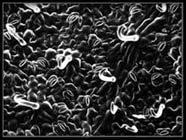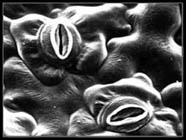Biosphere Contents
3. Photosynthesis
Land plants interact with their immediate environment via their roots, and the stomata in their leaves
Land plants generally obtain the water, nutrients and trace elements that they require from the soil in which they grow, via a root system. The nutrients and trace elements have to be in a dissolved form in order for them to be available for plants.



Carbon dioxide, however, is extracted from the air. Leaves of land plants have holes in them called stomata which allow for the exchange of gases, carbon dioxide being taken up, and oxygen and water vapour being lost. Through stomata, water is transpired (i.e. emitted) from the leaves. Transpiration creates surface tension, which helps pull a stream of water upwards from the roots of the plant. This stream of water follows transport vessels called xylem which are found in the stems of all higher plants. With this upward moving stream of water, dissolved ions are carried up from the roots to the leaves. Water is taken from the soil into the roots by osmotic forces, balancing the amount of water transpired and lost from the plant. In hot, dry, climates, many plants have adaptations to limit the amount of water lost through transpiration (for example, the stomata may close during hot weather).
What are stomata?